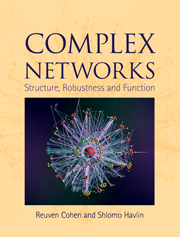Book contents
- Frontmatter
- Contents
- 1 Introduction
- PART I RANDOM NETWORK MODELS
- PART II STRUCTURE AND ROBUSTNESS OF COMPLEX NETWORKS
- PART III NETWORK FUNCTION: DYNAMICS AND APPLICATIONS
- Appendix A Probability theoretical methods
- Appendix B Asymptotics and orders of magnitude
- Appendix C Algorithms for network simulation and investigation
- References
- Index
Appendix A - Probability theoretical methods
Published online by Cambridge University Press: 05 August 2013
- Frontmatter
- Contents
- 1 Introduction
- PART I RANDOM NETWORK MODELS
- PART II STRUCTURE AND ROBUSTNESS OF COMPLEX NETWORKS
- PART III NETWORK FUNCTION: DYNAMICS AND APPLICATIONS
- Appendix A Probability theoretical methods
- Appendix B Asymptotics and orders of magnitude
- Appendix C Algorithms for network simulation and investigation
- References
- Index
Summary
In this appendix we will briefly describe probability theory and methods that will be used throughout the book. For a more complete treatment of probability theory, see any standard textbook on probability theory, such as [Fel68].
Probabilities and distributions
The main concept in probability theory is that of a probability space or an ensemble. The probability space consists of different objects or events, each of which has a measure – probability – assigned to it.
When each event is assigned a number, this number is termed a random variable. The random variable can be either discrete, in which case the measure is termed a probability distribution, or continuous, in which case the measure is termed “probability density.” The single events then have an extremely small probability of occurring and only the probability of a range of values, obtained through integration assuming that the probability density is finite.
When a finite number of events exists, say N events, the most common case is to assume they are equiprobable. Therefore, the probability of finding some property is P = M/N, where M is the number of events having the property. If P = 1 − f(N), where limN → ∞f (N) = 0, (i.e., the probability of finding the property approaches 1, when N becomes large) the property is said to hold almost always (or a.a.). In this book, when a property is said to hold, it actually means that it almost always holds.
- Type
- Chapter
- Information
- Complex NetworksStructure, Robustness and Function, pp. 207 - 212Publisher: Cambridge University PressPrint publication year: 2010



